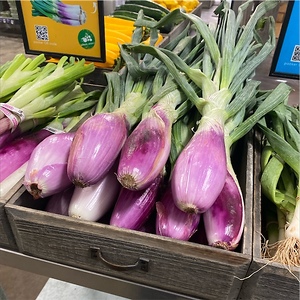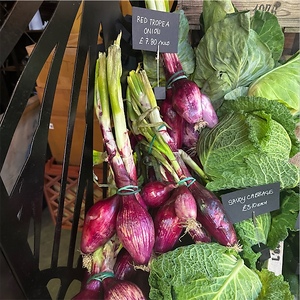


Rossa di Tropea Onions
Estimated Inventory, lb : 0
Description/Taste
Rossa di Tropea Calabria onions are small to medium in size, averaging 7 to 10 centimeters in length and 5 to 6 centimeters in diameter, and have a round, ovoid, to elongated shape with tapered ends. The size and appearance of the onion will vary depending on the specific variety and season harvested, but the most well-known type of Rossa di Tropea Calabria is the torpedo-shaped onion that has a longer and thinner nature than other commercial red onions. The exterior of the onion features layers of brittle, dry, and papery red, brown, and purple peel. When these layers are removed, a firm, red-purple, glossy, and smooth surface is revealed with light striping. Rossa di Tropea Calabria onions are comprised of ringed flesh found in shades of purple, purple, and red. These rings are fleshy, crisp, firm, and aqueous with a crunchy, succulent, and snappy consistency. The onions release a prominent, savory aroma and can be eaten raw or cooked, bearing a mild, sweet, and light flavor without the pungency commonly associated with standard onions.
Seasons/Availability
Rossa di Tropea Calabria onions are available at different points in the year, depending on the specific variety, and are generally found fresh in markets from the fall through spring. Dehydrated onions are available year-round.
Current Facts
Rossa di Tropea Calabria onions, botanically classified as Allium cepa, are protected onion varieties grown in Italy, belonging to the Amaryllidaceae family. These onions have been produced in specific coastal regions of Southern Italy for thousands of years and are a symbol of the area of Calabria. Multiple types of onions are collectively found under the name Rossa di Tropea Calabria, known as Tondo Piatta or early ripening, Mezza Campana or mid-season, and Allungata, late ripening. These types are further categorized as Cipollotto or scallion, Cipolla Fresca or Fresh onion, and Cipolla de Serbo, or Preserved or Dried onions. Cipollotto onions are harvested in October and resemble spring onions in appearance. Cipolla Fresca are gathered in April and have a red bulb with a long stem. Cipolla de Serbo onions are picked in June and are bright red with an elongated, torpedo-like shape. As a whole, Rossa di Tropea Calabria onions are known worldwide for their sweet taste. Calabrian residents claim the best Rossa di Tropea Calabria onions can be eaten like an apple, as they contain fewer acids in the flesh that give common onions their pungency. Rossa di Tropea Calabria onions are also grown in a mild, coastal climate with unique soil, contributing a higher water content to the bulb, allowing the taste of the flesh’s sugar content to shine, creating a sweet flavor. Throughout history, Rossa di Tropea Calabria onions have been affectionately nicknamed by Italians “La Regina Rossa,” meaning “The Red Queen,” and are also known as Calabria’s Red Gold. The onions are a signature crop of the Calabria region and are hand-harvested each year as a culinary delicacy. Rossa di Tropea Calabria onions are easy to digest and are famous for their ability to be widely used in sweet or savory preparations.
Nutritional Value
Rossa di Tropea Calabria onions are a source of vitamin C to strengthen the immune system, iron to develop the protein hemoglobin for oxygen transport through the bloodstream, calcium to build strong bones and teeth, and vitamin A to maintain healthy organ functioning. The onions also provide potassium to balance fluid levels within the body, vitamin E to protect the cells against the damage caused by free radicals, phosphorus to repair tissues, and other nutrients, including magnesium, selenium, zinc, and iodine. Rossa di Tropea Calabria onions are lower in sulfur compounds and pyruvic acid, components that give onions their sharp flavors, contributing to the variety’s sweeter taste. The onions have also been used in Italian natural medicines as a remedy to lessen headaches, ward off sicknesses, and help improve overall health. Onions were sliced in half and placed beside beds to open airways when suffering from colds in Italy. They were also rubbed on wasp stings to reduce itching and inflammation.
Applications
Rossa di Tropea Calabria onions have a sweet, aromatic, and delicate herbal flavor suited for fresh and cooked preparations. The onions are renowned for their sweetness and are unique as they are popularly eaten raw. Rossa di Tropea Calabria onions are chopped and mixed with herbs such as oregano and olive oil, a fresh mixture to eat with bread, cured meats, olives, and cheese as an appetizer. The onions can also be served with melted cheese and pepperoncino jelly, layered onto sandwiches and burgers, or tossed in olive oil and eaten by themselves. In Italy, onions are often seen in salads or placed on bruschetta. Pickled Rossa di Tropea Calabria onions are eaten with anchovies as an appetizer, and a traditional Italian farmer breakfast includes raw onions and bread. In addition to fresh preparations, Rossa di Tropea Calabria onions are famously simmered into jams and caramelized chutneys. The onions develop savory-sweet, rich nuances when heated, and these spreads are slathered on bread, hams, salamis, cheeses, and crackers. Rossa di Tropea Calabria onions are a foundational ingredient in soffrito, a blend of onions, celery, and carrots used for stews, soups, and sauces, and the onions are also utilized as a pizza topping, incorporated into pasta dishes, cooked with beans, added to egg-based dishes, or stuffed with dried fruit and vegetables and served as a main dish. Rossa di Tropea Calabria onions are grilled or roasted when in season and are eaten with ricotta, vegetables, and seafood. The onions are also customarily baked in salt and drizzled with olive oil as a tender side dish. Beyond well-known recipes, Rossa di Tropea Calabria onions are unconventionally incorporated into cakes, ice cream, tarts, and brioches. They are also dehydrated, ground, and sprinkled over dishes or cooked into sauces. Rossa di Tropea Calabria onions pair well with cheeses such as pecorino romano, mozzarella, parmesan, and provolone, tomatoes, zucchini, potatoes, garlic, herbs including basil, mint, oregano, and rosemary, seafood such as octopus, fish, and crab, and meats including veal, pork, and beef. Whole, unwashed Rossa di Tropea Calabria onions should be immediately consumed for the best quality and flavor when fresh. The onions will keep for a few days when stored in a cool, dry, and dark location. Braided and dried onions will keep around one month when placed in a cool area with ample air circulation away from direct sunlight.
Ethnic/Cultural Info
The name Rossa di Tropea stems from the municipality of Tropea in Southern Italy. It is said that the onions became popular after being shipped through the railway station and commercial port in Tropea, and they eventually acquired this name from people referencing the region-specific onions. The name of the municipality is also steeped in folklore. Legend has it Tropea stems from the story of Hercules. When Hercules returned from Spain after completing his labors, he rested on a cliff on a beautiful coastline. Hercules decided to establish a port in the region, and the coastal area eventually became a bustling port city called Tropea. Each fall in Tropea, Rossa di Tropea Calabria, onions are celebrated at a festival in the onion’s honor. The festival aims to promote the protected onions and highlight their versatility in culinary preparations through live cooking demonstrations, homemade goods, and street food vendors. The festival also features live entertainment, classes, and other social gatherings.
Geography/History
Rossa di Tropea Calabria onions are native to Italy and are descendants of onion varieties introduced to the Italian peninsula through the Phoenicians and the Greeks. It is thought that the Phoenicians, who were from the area now known as modern-day Lebanon in the Middle East, may have introduced onions in the Vibonese area of Calabria. Commercial trade routes were also established in the port of Parghelia, and the Greeks made trading stops in the region of Calabria and other southern Italian cities. These regions were a part of the Magna Grecia, which were areas of Greek city-states. Over time, these city-states transformed politically and economically into Italian regions, but in ancient times, these areas were controlled by the Greeks, heavily influencing crops, culture, and overall lifestyle. After the onion's introduction through trade, onions were planted and cultivated along the coast, and these varieties were selectively bred over time, changing in flavor and appearance due to unique terroir. Onions grown in the province of Vibo Valentia were referenced by several writers, philosophers, and naturalists, including Aristotle, Pliny the Elder, and Strabo. In the medieval era, from 476 CE to 1450 CE, onions were adopted among growers in Tropea as a signature crop. In the 18th to 19th centuries, mainly during the Bourbon period, onions grown in Calabria were being recognized and shipped to northern European markets, increasing in demand as a favored culinary ingredient. Today, Rossa di Tropea Calabria onions are a protected species and were given a Denomination of Origin and Protected Geographical Indication in March 2008. A Consorzio di Tutela della Cipolla Rossa di Tropea Calabria I.G.P. was also established to promote, protect, and preserve the quality, flavor, and cultivation of the red onions. Rossa di Tropea Calabria onions are grown in fertile, sandy, alluvial soils with a clay-like texture along the coast of Southern Italy. The onions sold under the protected label are only grown along a 60-mile stretch of coastal land spreading across parts of the Calabrian municipalities of Vino Valentia, Nicotera, Joppolo, Tropea, Drapia, Zungri, Ricadri, Spilinga, Pizzo, Briatico Parghelia, Zambrone, Zaccanopoli, Curinga, Nocera Terinese, Lamezia Terme, Gizzeria, Falerna, Longobardi, Amantea, Belmonte, and Fiume Freddo. When in season, Rossa di Tropea Calabria onions are sold in large piles at local markets, purchased directly from grower’s trucks in neighborhoods and town squares, or strung in braided groupings along awnings, doorways, and ceilings of shops throughout Southern Italy. The onions are also sent to other regions of Italy and are sold in markets, including Rome, and exported to countries worldwide as a delicacy.









